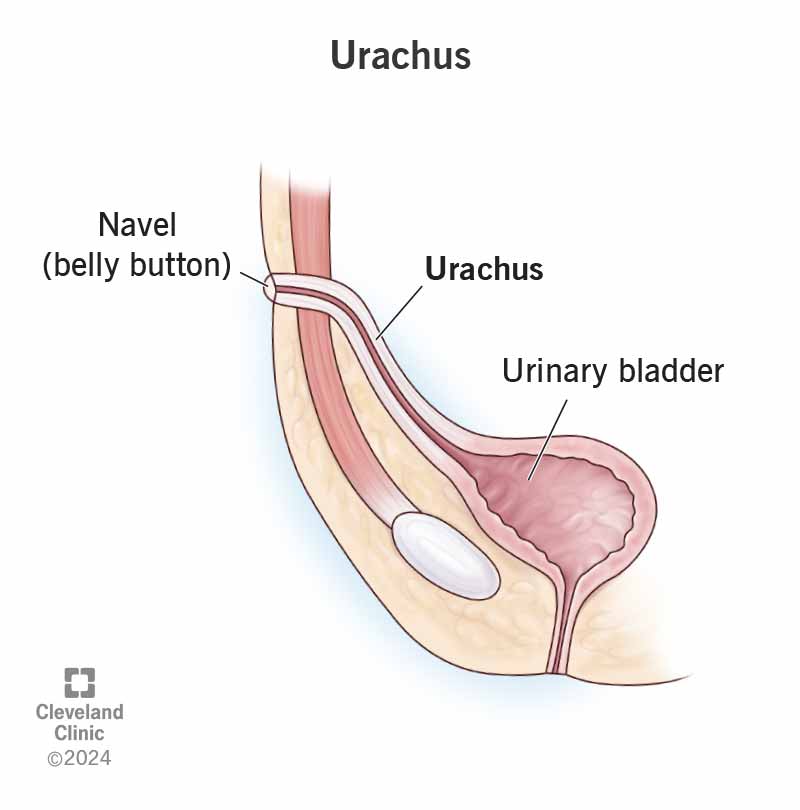The urachus is the canal between the belly button and the bladder in a fetus which helps drain pee. This canal usually closes before birth. But sometimes it doesn’t develop and abnormalities may occur. If you have symptoms, it may include wetness around the belly button. Urachal abnormalities are treatable.
Advertisement
Cleveland Clinic is a non-profit academic medical center. Advertising on our site helps support our mission. We do not endorse non-Cleveland Clinic products or services. Policy

The urachus (yer-UH-kus) is a fibrous tube (canal) that extends between the urinary bladder to the navel (belly button) in a fetus. It’s how pee (urine) leaves the fetus during the first trimester.
Advertisement
Cleveland Clinic is a non-profit academic medical center. Advertising on our site helps support our mission. We do not endorse non-Cleveland Clinic products or services. Policy
In most fetuses, the urachus closes before birth — usually during the last week or so of the first trimester.
No, the urachus isn’t the belly button. It’s a tube where pee initially drains during the first trimester.
Your belly button is the spot where the umbilical cord attaches to your abdomen as a fetus. A healthcare provider cuts it shortly after birth. The umbilical cord carries oxygen and nutrient-rich blood to a fetus. It also carries away pee that it receives from the urachus.
During the first trimester, the urachus helps remove a fetus’s pee through the mother’s placenta by way of the umbilical cord. As the fetus develops, its bladder begins to move toward its pelvis. As this happens, the urachus stretches and develops into a small, fibrous cord (median umbilical ligament).
In most adults, the urachus develops into the median umbilical ligament. But about 33% of adults still have some urachal tissue. Many adults with urachal tissue don’t even realize it because it usually doesn’t cause any problems.
All fetuses have a urachus, regardless of their sex. Most of the time, the urachus develops into a ligament at the end of the first trimester.
The urachus extends between the top-front part (dome) of a fetus’s bladder and belly button.
Advertisement
The urachus looks like a thick tube or cord. It may pinch in (taper) at both ends, or one end may be wider than the other, like a funnel. The length of a urachus can vary between 1 centimeter and 15 centimeters (about 0.4 inches to 6 inches) — a little shorter than an aspirin tablet or about as long as a pen.
If a healthcare provider thinks your baby might have a urachal problem, they’ll recommend an ultrasound. An ultrasound is a painless, noninvasive imaging test that allows providers to see your baby’s internal tissues and organs. They may also recommend an MRI. An MRI is another type of painless imaging test.
If a provider suspects that your baby has a patent urachus and that wetness around their belly button is coming from their bladder, they’ll test the fluid to see if it contains urea or creatinine. Urea and creatinine are waste products that typically leave their body through their pee.
Another test that can provide a clear view of the tissue behind your baby’s belly button is a voiding cystourethrogram (VCUG). During a VCUG, a provider injects a dye through their urinary system into their bladder. A VCUG is useful if your baby also has a problem with their bladder’s structure.
A urachal remnant is when the urachus doesn’t close. There are different types of urachal remnants, which include:
Advertisement
Another name for a urachal remnant is a urachal abnormality.
Urachal cancer is a rare type of bladder cancer. It most often appears in people who are 50 or older who have urachal tissue. Urachal cancer symptoms may include:
A healthcare provider may recommend chemical cauterization if your baby has persistent wetness around their belly button area. During chemical cauterization, a provider applies a small amount of a chemical (like silver nitrate, ferric subsulfate solution or aluminum chloride hexahydrate). The chemical usually helps the area heal within a few days. They may need to take antibiotics afterward.
Antibiotics are also very effective at treating urachal cysts. In some cases, a provider may need to drain fluid from the cyst with a needle. After the cyst heals, your baby may need surgery to remove the urachus and anything that connects to it, like the top of their bladder. Leaving urachal tissue behind increases your baby’s risk of developing urachal cancer or other conditions, including infections or bladder stones. But most people who have a provider remove their urachal tissue don’t have any further problems.
Advertisement
The urachus plays an important role in fetal development, helping pee drain before it eventually closes and changes into a ligament as the rest of the urinary system develops. In some people, the urachus doesn’t close before birth and urachal abnormalities occur. Urachal abnormalities may not cause any symptoms, and you may not even know you have one. But if it does cause symptoms, it’s typically treatable.
Advertisement
As your child grows, you need healthcare providers by your side to guide you through each step. Cleveland Clinic Children’s is there with care you can trust.

Last reviewed on 11/15/2024.
Learn more about the Health Library and our editorial process.